Menu
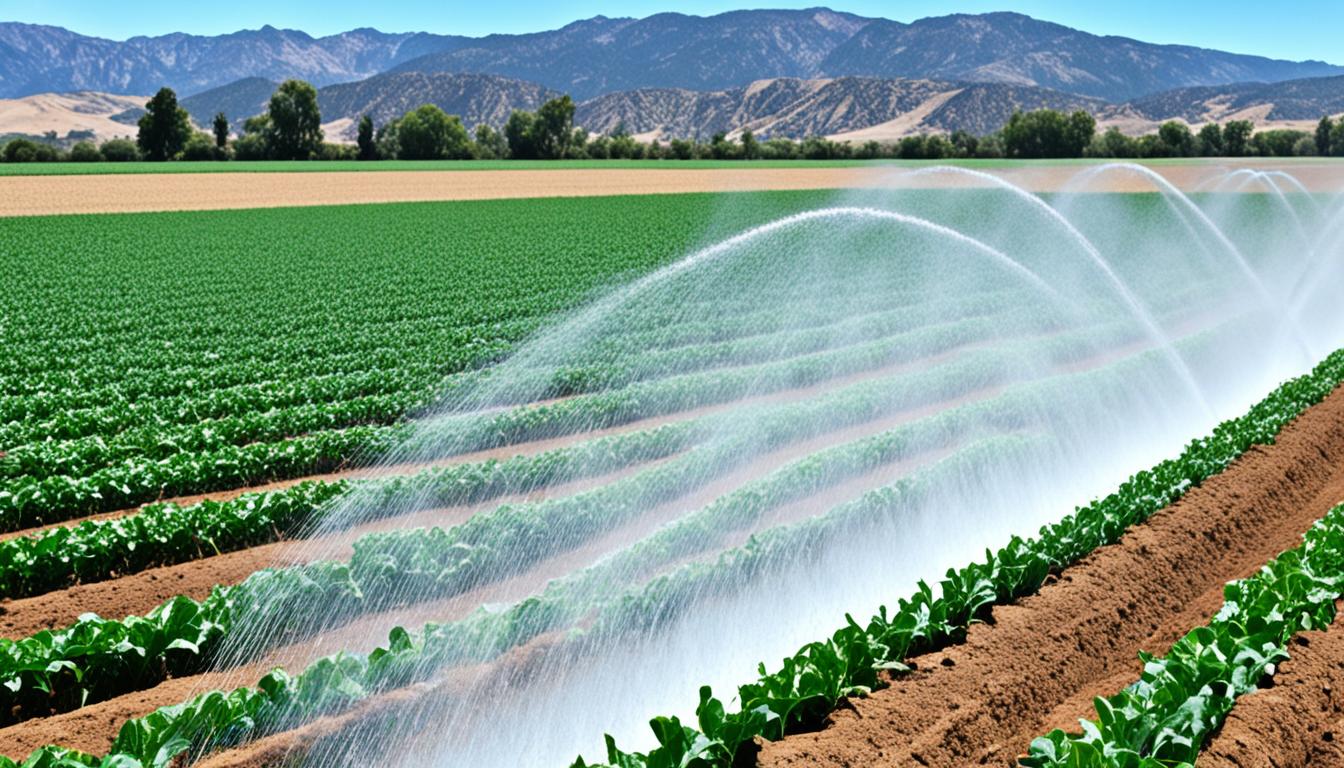
By 2028, the aim is for over 70% of farmers and land managers to care for the land while growing food. This big number shows a big change in farming towards being more eco-friendly. Changes started on January 1, 2021, and continue till 2027 through big changes in rules.
Agriculture in the United States is vital for our environment, affecting air and water, climate, wildlife, and our health. The Farm Bill, renewed every five years, supports key conservation and research for good farming practices. With no new Farm Bill for 2023, there’s an extra year till September 30, 2024. This time lets us review and improve farming policies to better fit new environmental rules.
In 2024, the Farm Bill plays a key role in setting sustainable law changes. It’s essential for making sure our agricultural policy works well. The bill doesn’t just decide on subsidies. It also pushes for green changes, especially in conservation and research.
These changes help with health efforts, improving rural areas, and boosting trade. So, the Farm Bill affects a lot, making it very important.
The current Farm Bill runs until 30 September 2024. This got extended because of political disagreements in 2023. Now, it’s a major time for farmers to watch for any new rules around environmental responsibility and policy impacts.
| Program | Annual Funding ($ Billions) |
|---|---|
| Conservation Programs | 6 |
| Environmental Quality Incentives Program and Conservation Stewardship Program | 3 |
| Conservation Reserve Program (CRP) | 2 |
| Agricultural Conservation Easement Program | 0.4 |
The Farm Bill’s importance for the environment is huge. Taxpayers mostly fund over 60% of big farming businesses’ insurance. But a third of these funds just help insurance companies, not farmers.
Changing this is key to more eco-friendly policy changes. Now, crops like vegetables and fruits get very little help. Yet, “horticulture” is supported with less than half a billion every year. Boosting support for these crops, over the usual corn and soy, could make farming more sustainable.
The Farm Bill is key in improving how we take care of our planet. It helps farmers deal with big environmental issues. The Farm Bill focuses a lot on two main programs – the Environmental Quality Incentives Program and the Conservation Stewardship Program.
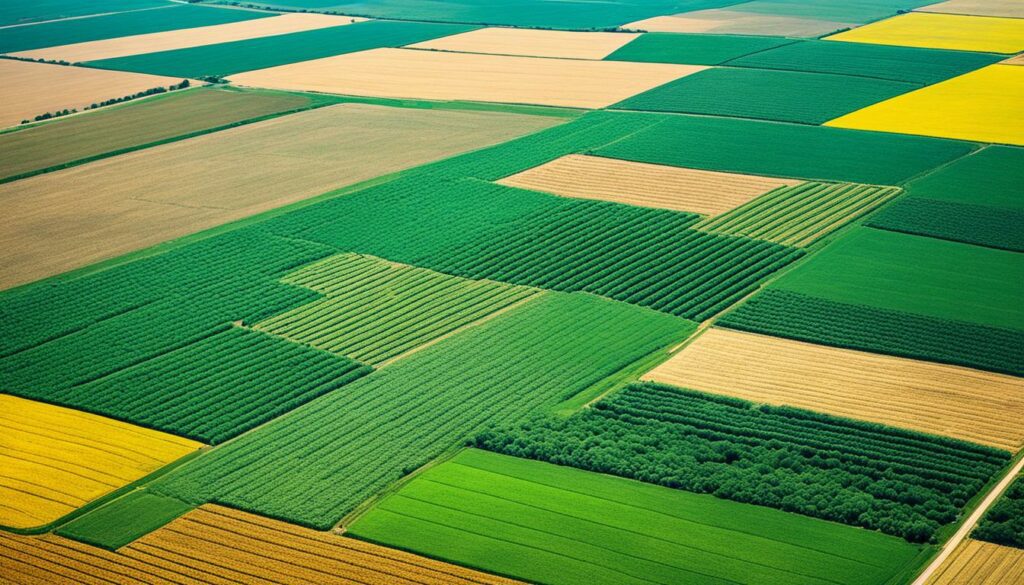
The EQIP gives farmers money and advice to farm eco-friendly. It spends about $3 billion a year on green farming. Now, thanks to the Inflation Reduction Act, it will get an extra $8.45 billion over the next four years. This boosts its support for sustainable farming.
The CSP is also vital for good environmental farming. Despite getting $3 billion a year together with the EQIP, there’s a need to make sure these efforts really advance good farming. The Farm Bill shows a big commitment to long-lasting farming practices, but it still needs tweaks to fight climate change better.
Making these programs focus better on environmental issues could radically improve our planet. We need to spend money on efforts that make the most difference. This requires very smart rules that put the planet first.
| Program | Annual Funding | Key Focus |
|---|---|---|
| Environmental Quality Incentives Program (EQIP) | $3 billion | Technical and financial assistance for sustainable practices |
| Conservation Stewardship Program (CSP) | $3 billion | Support for effective eco-practices through comprehensive resource management |
| Conservation Reserve Program (CRP) | $2 billion | Encouragement of carbon sequestration and protection of sensitive land |
The success of making these programs work better lies in always checking and perfecting them. This way, both the EQIP and the CSP will stay useful in reaching our farming and environmental goals.
Climate Hubs play a key role in helping with sustainable farming advancement across the USA. They bring together research, local farming knowledge, and teamwork to fight climate change. Their importance is clear, but they face challenges in getting enough public funding and support.
Climate Hubs need strong public agricultural research support to succeed. Without enough funds, they can’t improve agricultural practices sustainably. The USDA is making efforts to help by placing young people in the Working Lands Climate Corps. More support is also coming from the American Climate Corps for environmental justice and farming equity.
Climate Hubs also give out fellowships for research on climate adaptation and mitigation. For example, the Midwest Climate Hub offers a fellowship in Agricultural Meteorology. These programs show that funding for research is vital for good farming practices.
Aid for agroforestry is key in the fight against climate change. Agroforestry mixes trees and shrubs into farming to boost biodiversity, soil health, and soak up carbon. Yet, this practice doesn’t get enough support.
The USDA is working hard to promote agroforestry, with many fellowships available. Still, more funding and support are needed for agroforestry to make a big difference. The Farm Bill’s updates could help make sure agroforestry and Climate Hubs get the support they need.
The USDA wants to make the USA food system more resilient and sustainable. They also want to get young people involved in protecting the environment. Investing in a clean economy, and supporting the Indian Youth Service Corps, shows how important research support and agroforestry are for the future of farming.
The agricultural sector faces new environmental rules in 2024. These aim to make farming more eco-friendly. In this briefing, you’ll learn the key changes to keep your farm green and agricultural environmental compliance.
The new Farm Bill gives $6 billion each year for green farming. It helps with programs like EQIP and CSP that offer $3 billion yearly. These programs support farmers shifting to sustainable farming transition.

Also, there’s the CRP that pays out $2 billion a year to help store carbon. This shows how important the green compliance guidelines are. Plus, the Inflation Reduction Act plans to spend over $8 billion on green projects in the next four years.
The introduction of regional climate hubs is big news. They link USDA’s research with local farmers. Not only should each hub get $50 million a year, but they also help spread climate-savvy farming tips.
About 60% of agribusiness insurance is funded by taxpayers. Knowing the latest farmer guidelines updates helps farmers make the most of these benefits. Also, 62% of direct subsidies will go to crops like corn and soy in the coming years. It’s important for farmers to keep up.
| Program | Annual Funding ($ billions) | t
|---|---|
| Farm Bill Conservation Programs | 6.0 | t
| Environmental Quality Incentives Program (EQIP) & Conservation Stewardship Program (CSP) | 3.0 | t
| Conservation Reserve Program (CRP) | 2.0 | t
| Climate Hubs Funding | 0.05 | t
Farmers must welcome the sustainable farming transition with these supports. Staying informed ensures you meet the 2024 rules and make the most of the benefits.
Changes to the Conservation Reserve Program (CRP) in the U.S. have made a big impact. They aim to help the environment and the economy.
The CRP now offers new incentives for farmers. These are focused on encouraging greener farming methods. The Farm Service Agency (FSA) tells us that a lot of land has been enrolled in these programs already.
Improvements and new incentives began in 2021. They focus on fighting climate change. The aim is to protect the environment for the long term. This includes planting trees, keeping grasslands, and helping wildlife habitats.
The FSA is also starting a Forest Management Initiative in 2024 for better woodland management. This will help with re-growing important natural areas and capturing carbon.
Improving habitats for wildlife is a major focus now. The CRP helps farmers make areas that welcome wildlife. This helps in many ways like cleaner water, less soil erosion, and saving habitats.
Farmers can join these efforts each year through CRP’s various programs. Over $1.77 billion has gone to these environmental projects. Over half a million farmers and landowners have taken part this year.
The CRP aims to enroll up to 27 million acres by 2024. Already, 24.8 million acres are in the programme. Senators are even looking at extending the help for up to 30 years for some lands. This is to ensure longer efforts to save wildlife.
These CRP changes are a step towards greener farming and helping wildlife. They show how farmers can make a big difference in nature protection and fighting climate change.
Agricultural sustainability is more important than ever. This leads to a growing need for eco-friendly farming incentives. They include conservation easements and farmer training initiatives. These steps help maintain a healthy environment. They encourage farming that’s good for the planet.
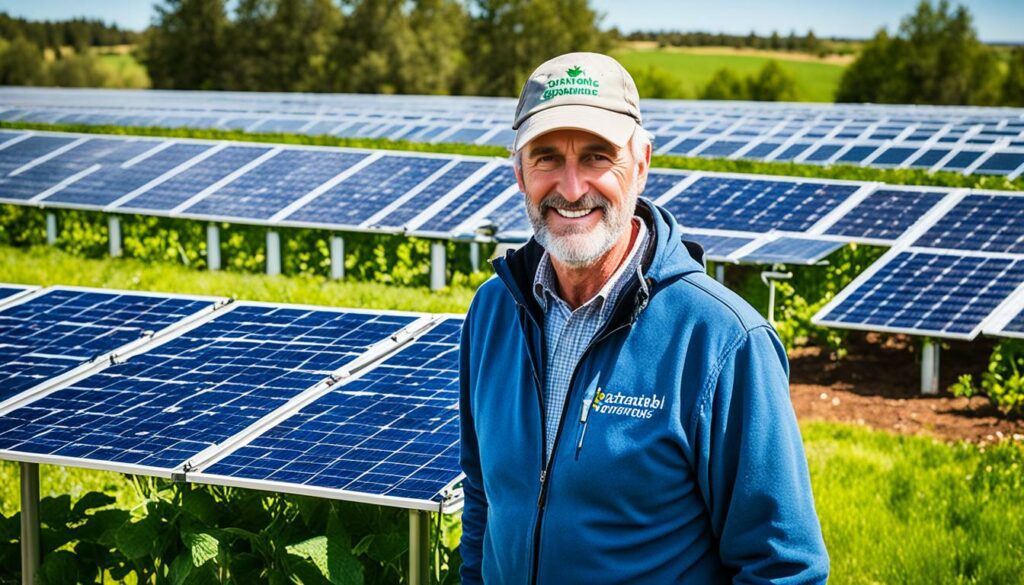
Conservation easements play a key role in the U.S.’s environmental efforts. The Farm Bill commits $6 billion a year to these efforts. This shows how important they are and how widely they’re used across the country.
More than 70% of privately owned land in the lower 48 states fits into these programmes. They’ve been protecting wildlife and open spaces for over 40 years. Through the ACEP, the Farm Bill safeguards vital lands and helps improve water and wildlife areas.
These easements help with carbon sequestration, better water, and soil health. They also reduce greenhouse gas emissions significantly. Due to their success, recent years have seen more funding dedicated to these efforts.
Farmer-to-farmer training is essential in spreading sustainable farming. The USDA supports this work through nearly $1.8 million in cooperative agreements. It aims to boost the understanding of programmes like the CRP-TIP.
CRP-TIP focuses on helping various farmers and ranchers. It offers them extra rental payments if they lease land. This way, it supports both new and experienced farmers in choosing eco-friendly ways. The land must be sold or leased long-term to join. This encourages stability.
Success in these efforts comes from both the money and the shared knowledge. By emphasising training, farmers together fight climate change. They make sure that eco-friendly farming practices become common.
| Program | Annual Funding | Key Benefits |
|---|---|---|
| Conservation Easements | $6 billion | Healthier soils, cleaner water, carbon sequestration, wildlife habitat conservation |
| Transition Incentives Program (TIP) | Approximately $1.8 million | Supports beginning, veteran, and socially disadvantaged farmers through additional rental payments |
These initiatives deeply impact agriculture, marking a shift towards sustainability. Supporting conservation easements and farmer training is crucial for a sustainable future in farming.
The Inflation Reduction Act (IRA) strongly affects farming by funding green farming directly. This new law marks a big move towards eco-friendly and sustainable farming.
The IRA has given around $19.5 billion for the USDA’s eco-friendly programmes. This is a big boost in funding for green farming. Key areas getting support include:
Section 22006 of the IRA gives $3.1 billion to help farmers with FSA loans under financial stress. Section 22007 gives $2.2 billion to farmers who have felt unfairly treated in USDA loans. These parts clearly show how the IRA helps by offering crucial financial support.
The boost in funds also improves many conservation programmes:
| Program | Funding ($ billions) |
|---|---|
| Environmental Quality Incentives Program (EQIP) | 8.45 |
| Regional Conservation Partnership Program | 4.95 |
| Conservation Stewardship Program | 3.25 |
| Agricultural Conservation Easement Program | 1.4 |
| Conservation Technical Assistance Program | 1.0 |
Such a big investment shows how important it is for farming to change for the planet’s sake. The $8.45 billion for EQIP helps a lot in doing more eco-friendly farming. The $4.95 billion for the Partnership Programme means more team-work to meet green goals.
In short, the Inflation Reduction Act is crucial for making farms more sustainable. By funding eco-friendly efforts, it makes farmers want to use these methods. This Act is key to both eco-friendly law and a stronger, greener farming future.
The world of agriculture is changing fast. There’s a big push to make farming more green. But, the current crop insurance setup doesn’t always help with this. It actually makes farming in risky areas more tempting, adding to climate problems.
Another issue is that a lot of the money doesn’t reach the farmers. It goes to insurance firms and their agents. This setup is not good for the planet or the farmers trying to do the right thing.
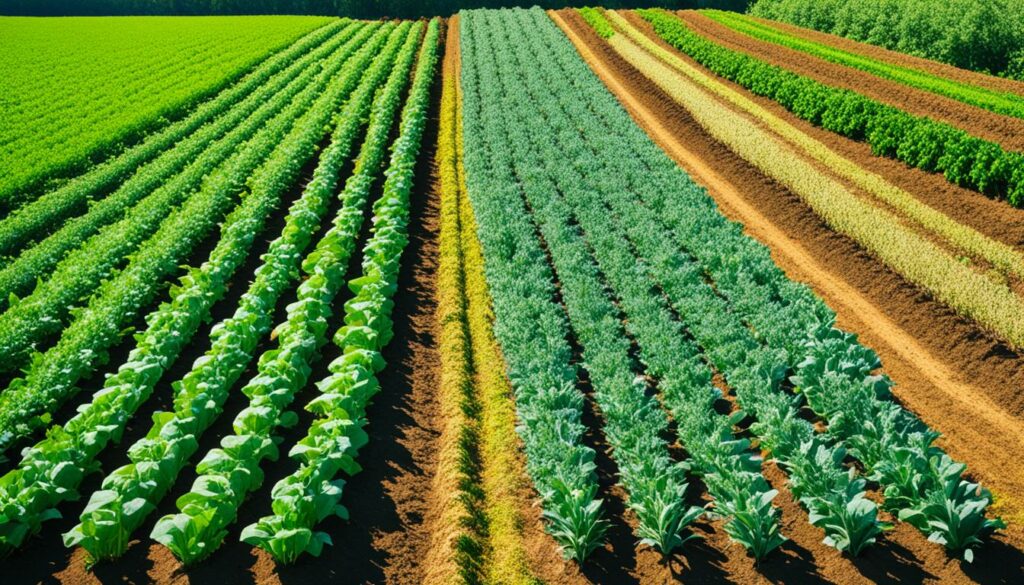
Right now, US taxpayers are footing over 60% of the bill for farm insurance. This big support mainly helps farmers who grow large crops like corn and soybeans. In 2016, these crops got over 77% of the help, which was more than $4 billion. But not much support goes to farmers who want to farm in ways that care for the environment.
Every year, over $6 billion goes towards programs that try to lessen the harm farming does to nature. But, the way insurance is given out doesn’t really encourage green farming. This needs to change.
In 2024, new green rules will lead to big changes in farming. The goal is to make crop insurance choices more focused on helping the Earth. Here are the main ideas to become more green:
| Funding Area | Annual Allocation ($ billions) |
|---|---|
| Conservation Programs | 6 |
| Crop Insurance Funding | 60% taxpayer-funded |
| Corn and Soybean Subsidies (2016) | 4 |
| CRP Program | 2 |
These ideas don’t just change how crop insurance works. They also fit with the plan for greener farming in 2024. By making the insurance schemes more about being good to nature, farming can be better for the planet and make money too.
In the nearing 2024, we expect a big change towards climate-friendly crops. The goal is to make more sustainable plant foods. These foods should help our climate more than usual feed and biofuel crops like corn and soy. We think this change will do good for the environment and our health.
Around $3 billion a year will go to green agriculture projects. This money will help farms be more kind to the planet. There’s also over $6 billion a year to help nature cope with farming and about $2 billion a year for letting some land rest, which helps store carbon.
Public research in farming lost a third of its funding from 2002 to 2019. Shifting this money to support eco-friendly farming could make a big difference. Plus, $8.45 billion is aimed to help farmers and their land be kinder to the environment for four years.
The U.S. wants us to eat more plant foods, say its guidelines. To do this, they plan to give more help to farmers who grow fruits, veggies, and plant foods. This help will be less for crops like corn and soy, which get most subsidies now. Changing this kind of support could really push for more green farming.
This push for more environmental-friendly crops shows how much rules can change things. It encourages farming in ways that help our climate. With these changes, farming could help make our planet healthier and give us better foods to eat.
Agroforestry plays a big role in fighting climate change. It’s the biggest way the farming sector worldwide can help. This method mixes trees and shrubs with farming to bring both environmental and economic wins.

Agroforestry has many advantages. It boosts crop yields and income variety for farmers. It also makes our food system more sustainable and able to cope with climate changes. In places like the Brazilian Amazon, it even fights against forest loss by giving farmers other ways to make money. Agroforestry systems can also pull out up to 0.31 billion metric tons of carbon each year. This is a big win for our climate.
Despite its benefits, agroforestry faces some tough challenges. The exact effect of agroforestry on carbon is not clear, and it’s hard to measure progress. Because agroforestry practices vary a lot worldwide, it’s tricky to compare their climate effects. For example, how much carbon different silvopasture systems store can vary by 100 times. The need for big initial investments and complex land management also make agroforestry hard to start.
To get over these challenges, we need more help for farmers. The US government, for example, put $60 million towards better agroforestry in 29 states. This support aims to fill the gaps in our knowledge and better understand which agroforestry systems can trap the most carbon.
At its core, agroforestry helps us produce food and lower carbon in the air. But, to really succeed, we need to tackle these challenges with careful plans and policies. We must encourage more people to use agroforestry on a bigger scale.
Farmers must keep up with the complex rules on agricultural compliance with environmental laws as we get closer to 2024. Laws for farming in a green way are getting stricter. These changes are part of a big push to care for our planet. Meeting these green rules is key for a future where farms work with nature.
Recently, a big number of buildings, over 27,919, tackled their carbon emissions from March 2021. This includes places on the LL97 Covered Buildings List. Thanks to the PACE rules, building owners can use their tax bills to finance green improvements. This shows a growing effort to be kinder to the Earth while keeping up with the law.
The OECA has put a spotlight on six top areas for farmers to watch out for from 2024 to 2027. These are big issues about the air, water, and land. They also think about fairness in how environmental benefits and troubles are shared. It’s important for everyone to do their part, from farmers to big businesses, to keep the planet healthy and follow the law.
Singapore, China, the UK, and New Zealand are now watching how much greenhouse gas they produce. Farms are a big part of this. So, farmers must report their emissions clearly. This makes the job of farming in a green way more important and challenging. But, it’s a step towards a cleaner future that we can all be part of.
The LL97 Mobilisation Council is working hard to help farmers meet these new rules. They have set up groups to focus on getting the money needed and sharing advice. This support is crucial. It helps make following the 2024 environmental laws easier for farmers who want to do what’s right for the planet and their pockets.
Following the law well means more than just knowing about it. Farmers need to take part in efforts that help the Earth. This can be through using solar energy or getting tax cuts for green projects. By doing these things, farmers can stick to the rules and help our Earth. It shows how farming can lead the way in caring for our world.
The way we farm greatly affects the planet and our health. Unfortunately, laws often keep farming practices hidden from the public. This lack of transparency mainly comes from the Farm Bill.
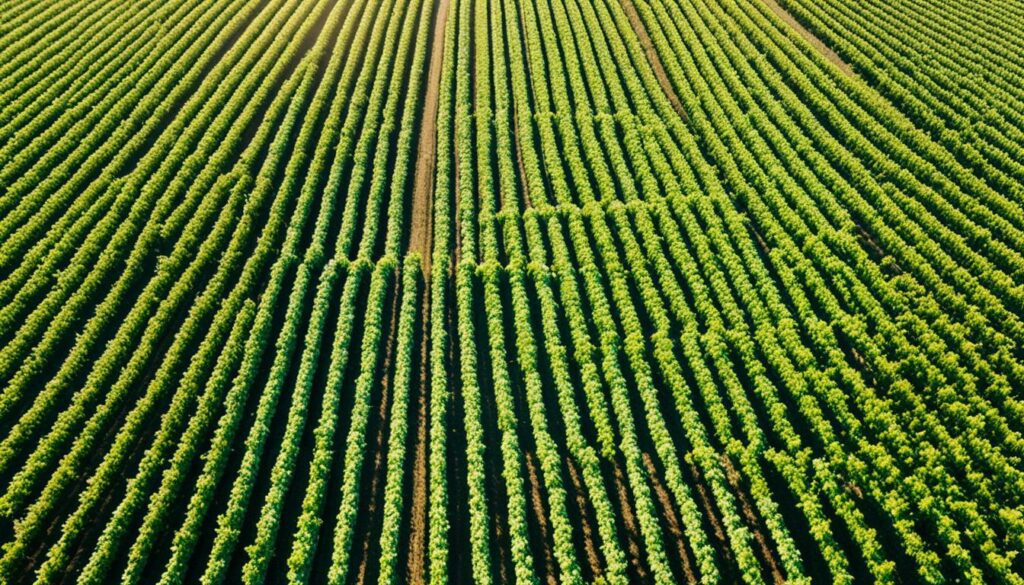
Many groups, including 6,000 experts, are against these secret rules. They say keeping farming data quiet stops us from making good choices. For example, a callout for opinions saw 88 detailed responses, showing how much people want this to change.
Sharing more about how we farm can bring big wins. It leads to smarter choices and makes farmers more responsible. President Biden’s push for bio-advancement supports this. And making farming clearer helps follow any new green laws.
Getting rid of these secrecy rules can make us understand farming’s effects on the earth better. The USDA, FDA, and EPA also want change. They focus on how to better control biotech products, saying we need to know more about what’s going on.
Supporting marginalised farming communities is important. It ensures everyone gets the resources they need. This way, we can build a strong, sustainable, and eco-friendly world for all. In 2019, gaps in work opportunities for women and people of colour led to a huge loss for the U.S. economy. Closing these gaps could boost our economy by trillions by 2029.
Federal agencies have come up with over 100 ways to help underserved farmers. The Treasury Department, for example, put nearly $9 billion into helping low- and moderate-income communities. They offered loans, grants, and help with payments. The Small Business Administration also made it easier for small businesses to get financial help by giving out new licenses.
The Department of Labor is working to raise wages in jobs mostly held by women and supporting those affected by workplace violence. The HUD’s PAVE Initiative fights unfair property appraisals. This is key for fair housing, which helps agricultural communities too.
The Department of Transportation is investing $185 million in improving community connectivity through better transport. This helps areas come back together through transport upgrades. Another $3.4 billion is set aside for this over five years.
The Health and Human Services Department is also playing its part. It’s extending medical coverage for new mothers to a full year. This move will help about 720,000 Americans each year, aiming for better health after giving birth.
Helping marginalised farming communities is crucial. Making sure everyone in farming gets support is key. Investing in farming’s diversity and inclusivity leads to better farming and caring for our planet.
In 2024, the agriculture industry in the U.S. took a big step towards being more green. New laws aim to make farming better for the planet. These rules offer a way forward but also bring challenges.
Farmers need to learn and follow the new laws. The Farm Bill now runs until late 2024 to help make this change possible. It supports efforts for better land use, research, and money for green farming.
This means farmers must understand the new rules to make the most of them. By being clear and up-to-date on these laws, the sector can move towards a healthy balance. It’s a journey towards farming that’s good for both business and the environment.
Farmers in 2024 will face updated environmental rules. These rules boost smart farming and eco-friendliness. They aim to improve farm practices for the planet’s health.
The Farm Bill shapes U.S. farm policy. It’s crucial in 2024 because of its impact on the environment and health. It also affects rural areas.
In 2024, the EQIP will focus more on real, sustainable farming. It will allocate funds carefully. This is to address climate problems in farming.
Climate Hubs bring together research and local farming info. They help farmers deal with weather changes.
The CRP will now reward practices that are good for the climate. It will focus on growing trees and saving wildlife spots.
Conservation easements keep farm land safe for nature. Farmer training helps spread the word about the best, green farm ways.
The Act supports greener farming with cash and ideas. It’s a big move towards greener agriculture.
Crop insurance is being changed to encourage eco-friendly farming. It will better prize green farming.
Climate-friendly crops need fewer resources. They also fight climate change better.
Agroforestry helps nature but needs careful land work and money. Good support is key to success.
Farmers should learn about new laws. They should work in ways that help nature. Training is a must for following rules.
Being clear in farming is vital for good choices and trust. There are limits on sharing farm data now. Efforts are on to make things clearer.
Helping all communities with funds boosts sustainable farming. It makes farms stronger for the future. Everyone working on farms together is better for the planet.